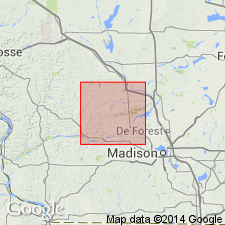
- Usage in publication:
-
- Parfreys Glen Formation
- Modifications:
-
- Named
- Areal extent
- Dominant lithology:
-
- Sandstone
- Conglomerate
- AAPG geologic province:
-
- Wisconsin arch
Summary:
Parfreys Glen Formation is here named in Sauk Co., south-central WI. Consists predominantly of sandstone but is very conglomeratic in many areas, coarsest next to Baraboo cliffs. Sandstone contains very fine to very coarse quartz sand. Color varies from white to yellow, gray, and brown. Contains pebbles, cobbles, and boulders of Baraboo quartzite. Unit occurs in band 2 km wide on both sides of North and South Ranges of Baraboo Hills and interfingers(?) with ascending Wonewoc, Tunnel City, St. Lawrence, Jordan, and Oneota Formations. Exposures along canyon walls at type section are approximately 30 m. Unconformably overlies Early Proterozoic "Rowley Creek slate" and unconformably underlies Mesozoic Windrow Formation. Scattered fossils indicate that at least part of the sandstone and conglomeratic sandstone in the Parfreys Glen is chronologically equivalent to the Tunnel City, St. Lawrence, and Jordan Formations. The angular talus lying against the cliffs is considerably older than the adjacent sandstone. Unit interpreted as Cambrian and Ordovician(?).
Source: GNU records (USGS DDS-6; Reston GNULEX).
For more information, please contact Nancy Stamm, Geologic Names Committee Secretary.
Asterisk (*) indicates published by U.S. Geological Survey authors.
"No current usage" (†) implies that a name has been abandoned or has fallen into disuse. Former usage and, if known, replacement name given in parentheses ( ).
Slash (/) indicates name conflicts with nomenclatural guidelines (CSN, 1933; ACSN, 1961, 1970; NACSN, 1983, 2005, 2021). May be explained within brackets ([ ]).

